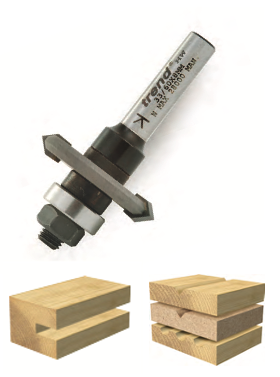 |
Slotting and grooving cutters These are primarily functional rather than decorative and usually consist of a standard arbor onto which you mount a selection of different blades to cut very precise slots or grooves. These cutters can be used singly or stacked up in various combinations to produce specific customised profiles. You can intersperse bearings, shims and spacers to control both the depth and the width of the finished cut. The slotting cutters consist of a flat steel blade which varies in thickness from 1.5 mm up to 20 mm in thickness, with diameters up to 50mm. The usual arrangement is for the disc to have at least two TCT teeth, each ground for precise cutting and clearance angles to ensure that waste clears quickly and freely. Specialised versions allow you to cut different width grooves with the same cutter. Other versions make decorative cuts in panels and frames to disguise glue lines, or to produce fluting effects. You can also use them to cut traditional tongue and grooving profiles. There are some threaded cutters that screw onto the arbor leaving no projection, which can then be used to cut flush to the inside of a frame, if for instance you are trying to deepen a recess to take double glazing units. Dedicated groovers do not use an arbor but are specifically shaped to cut slots for pipes, slat walls and drawer pulls, or for inserting intumescent strips or weatherseal. One very useful variation of the groover allows you to cut simple biscuit joints without having to go to the expense of a dedicated biscuit jointer machine.
  |

|
|
 Cookson Hardware, Stockport, Greater Manchester UK Online Architectural Ironmongers Friday 2nd January 2026 |




















